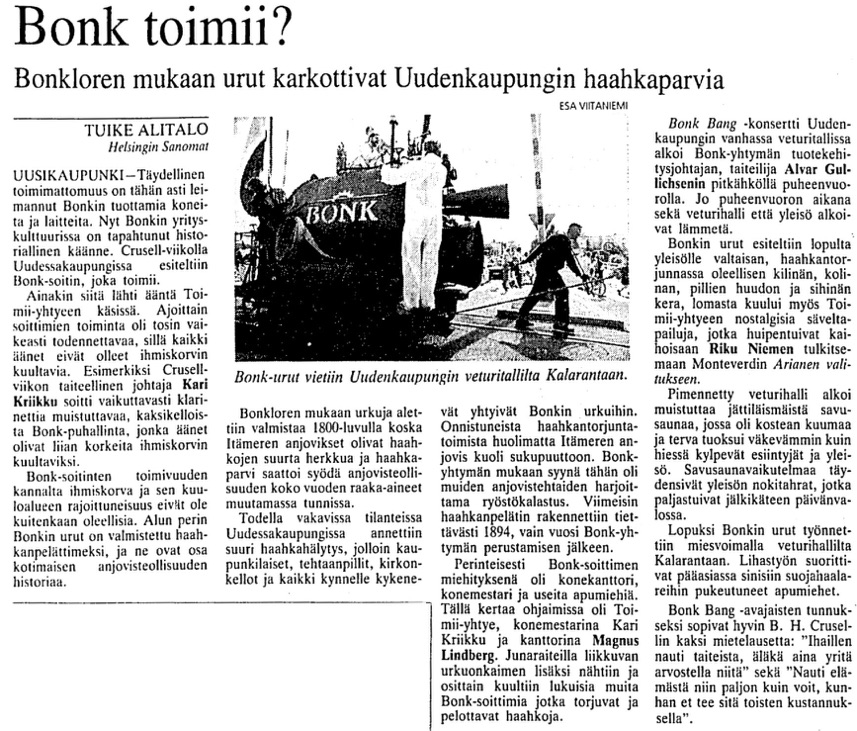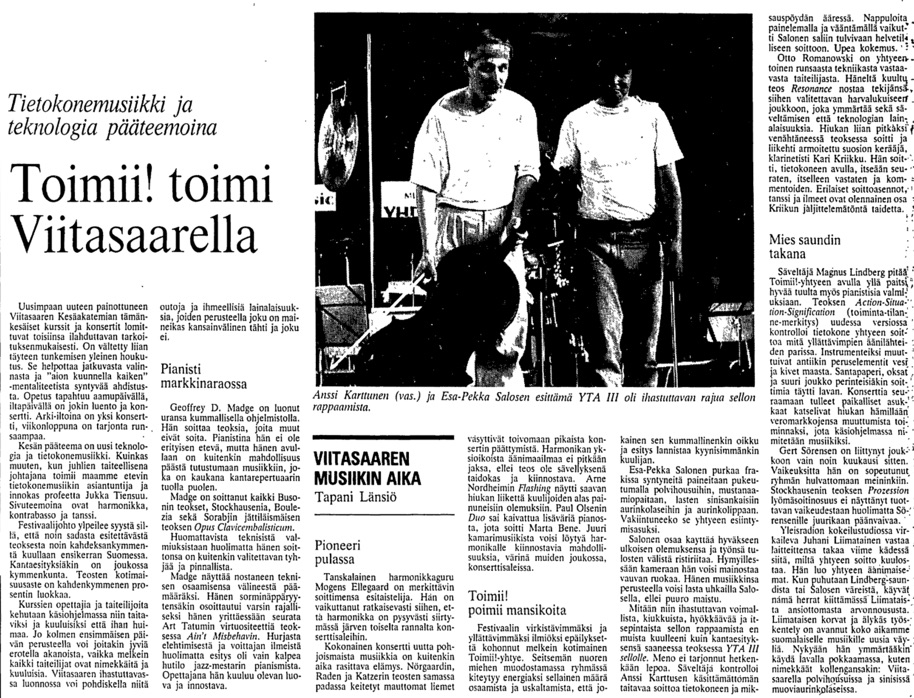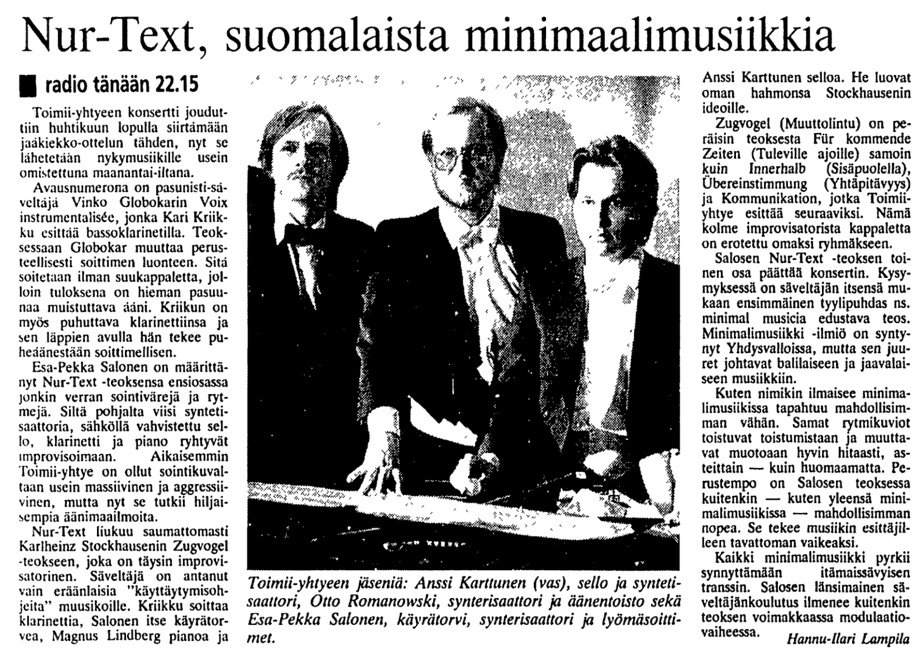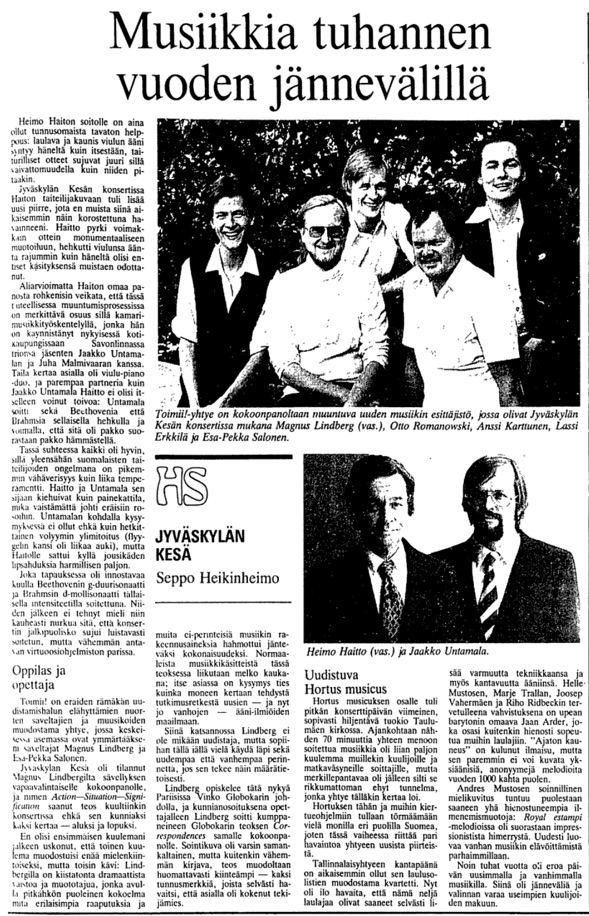The world writes about Toimii

Ojai Festival
Variety By Alan Rich
Tucked into a valley northeast of Ventura (which served filmmaker Frank Capra as a site for the original version of “Lost Horizon”), the town of Ojai (population 7,500) is no more than a 90-minute drive from downtown Los Angeles. One weekend a year, however, as this rural enclave of horse farms and orange groves hosts one of the world’s most sophisticated and adventurous music festivals, it might as well be the far side of the moon.
This past weekend was one such time. Founded in 1947, the Ojai Festival has from its inception concentrated on the cutting-edge musical repertory more grandiose European festivals would fear to touch. Ojai thrives on true grit. This year’s offerings consisted of an extraordinary (and spectacularly successful) feat of bridge building: America meets Finland, and finds much in common.
For his first-ever Ojai stint, Esa-Pekka Salonen brought over the intrepid new-music ensemble Toimii, which he and Magnus Lindberg founded in Helsinki in 1981; Toimii, in turn, brought over a week’s worth of new music that was mostly stupendous: music by Salonen himself and his two near-contemporaries Lindberg and Kaija Saariaho.
They also brought an hour’s worth of delicious operatic spoof for a morning family concert, whose catalog of delectables included the rare spectacle of Salonen himself, in a bunny costume, screeching out a few notes in the soprano stratosphere while leaping after invisible butterflies.
Of the new works, Lindberg’s 30-minute “Kraft” made the crowd immediately woozy with its huge sound panorama that enlisted both the Toimii membership and the Los Angeles Philharmonic in full panoply.
Much of the piece was techno-derived and enlisted percussion instruments galore (including a gathering of banged-upon auto parts worthy of early John Cage) as musicians dashed to improvised performance spaces all around the audience area while twittering piccolos serenaded (and were serenaded by) Ojai’s regular avian contingent. The work dates from 1985 (and was recorded on the Finlandia label two years later); this was its U.S. premiere and the ground at Ojai still may be shaking.
Lindberg’s music made a lot of noise at Ojai; it also included a cello concerto that showcased the phenomenal talent of Toimii’s cellist Anssi Karttunen, who was kept busy the next night by another killer solo work, “Amers” by Saariaho.
A new work by Salonen himself, “Five Images After Sappho,” won hearts with subtler means: music of elegant, long melodic flow, set for soprano and small ensemble. Salonen had composed the cycle for Dawn Upshaw, but that most lovable of singers underwent emergency spine surgery and was replaced by another American soprano less well known but eminently capable, Laura Claycomb. Remember her name.
....
Nähdä King Kong-Salonen ja kuola
Toimii-yhtye vaali jälleen pikkupojan sieluaan
Julkaistu: 16.8.1993 3:00
TAMPERE - Tampereen Tullikamarin täysi pakkahuone tiesi nauraa jo etukäteen. Toimii-yhtyeen Moccihopèro -irroittelun tiedettiin olevan hilpeä kunnianosoitus suomenruotsalaisten modernistirunoilijoiden muinaiselle dada-innostukselle.
Yllätysmomentti menetettiin, mutta Juha Hemánuksen ja Vivica Bandlerin ohjaus piti musiikillis-runollisen sketsiketjun niin liukkaassa liikkeessä, ettei ikävystymisestä ollut tietoakaan.
Ensin oli vain pimeä lava, muutama lumisateinen tv-ruutu ja loputonta, metallista puhemantraa suoltavat kovaääniset. Sitten oli Magnus Lindberg , Timo Korhonen, Kari Kriikku ja Anssi Karttunen ähkimässä megafoneihin dadaistista äännerytmittelyä.
Ja sitten, yleisön suureksi ihastukseksi, saapui Esa-Pekka Salonen Erik von Frenckellin yöpaidan taiteellinen toisinto päällään pyykkinarun takaa lavalle. Salonen asettui viininpunaiselle divaanille ja alkoi pestä hampaitaan. Nauruntirskahdukset yltyivät Salosen kuolatessa huuhteluveden lavalle.
Naurua vanhalle ja uudellekin musiikille
Teoksen Pierrot Lunaire -tyyppinen lauluosuus vaati solistilta huimia intervallihyppyjä ja ehdottoman kouliintumatonta ääntä. Salonen täytti kunniakkaasti molemmat vaatimukset.
Esityksen jatkuessa koettiin yksi tylsempikin kohta, jossa Salonen nosteli divaanilla maaten hitaasti numeroita esiin. Dadan surreaalinen taso saavutettiin vasta hiilihappojään pursuttua divaanin alta ja Salosen siirryttyä johtamaan köhähdys-kuoroa. Tässäkö muusikkojen kosto kaikista keuhkotautisen yleisön konserteissa aiheuttamista häiriöistä?
Visuaalisesti dadailun näyttävin temppu oli ilman muuta noin neljämetrisen King Kong -gorillan ilmestyminen lavalle sylissään häkki ja häkissä Salonen. Kesti aika kauan ennenkuin yleisö huomasi, että Salosella olikin allaan tekojalat ja gorillaturkin jaloissa tallusteli maestro itse.
Musiikkipuoli jatkui gorillanumeron jälkeen tutun moniaineksisena. Kuultiin Riku Niemen hurja jazz-soolo Vivica meets Monk sekä Magnus Lindbergin oma väännös ylistetystä orkesteriteoksesta Corrente.
Decorrenten soidessa lavan valkokankaalle heijastui kappaletta johtava Salonen, jota puolestaan matki lavalla lihallisesti oleva gorillahousuinen Salonen. Hän lopettikin kappaleen ennen valkokangaskuvajaistaan, joka jäi näin heilumaan tyhjän päälle. Ja taas meitä nauratti.
Ylimääräisenä kuultiin aidosti mauton, mutta hupaisa raiskaus Valse Tristesta. Kuolemasta kertova kappale sopi itseasiassa dada-teemaan hyvin. Syntyihän sattumanvaraisuutta ja lainvastaisuutta ihannoinut dada alkujaan reaktiona ensimmäisen maailmansodan mielettömyydelle.
----------------------------------------------------------------------------------------------------------------------------------------------------------

Salonen! Toimii!
Helsingin Sanomat 18.8.1993
TUSKINPA IHMISTÄ VOI sivistyneenä pitää, ellei hän ole osallistunut Tampereen Teatterikesään. Ongelmana siinä on vain se, että siellä on niin paljon teatteria.
Onneksi ilmeni, että Teatterikesän (ja kesän) viimeisenä päivänä olisi kaksi konserttia. Ruotsinmaalainen Rikard Wolff esitti laulelmia. Hän oli kovin korea poika, jotakin tuolta nuoren Tauno Palon ja nuoren Stewart Grangerin välimailta.
Yleisö olikin naisvoittoista ja perin ihastunutta. Miltei saattoi aistia miten tuolit kostuivat kuin Minna Lainiolla konsanaan.
TOINEN KONSERTTI OLI vielä jäljellä. Esa-Pekka Salonen johtaisi Toimii!-yhtyeen konsertin Moccihopero.
Olen jo vuosikymmeniä toivonut joskus näkeväni kapellimestari Esa-Pekka Salosen. Olen leikannut lehdestä satoja ylistäviä arvosteluja eri puolelta maailmaa.
Nyt siihen tarjoutuisi tilaisuus! Esa-Pekka lentäisi suoraan Los Angelesista Tampereelle, Tullikamarin pakkahuoneeseen.
ESITYS ALKOI. Ensin kuului kaikenlaista akustista hälyä, mutta sekään ei jaksanut Salosen odottajaa harmittaa.
Sitten Salonen saapuikin! Hän notkahteli jostakin pimennosta väljähkö, virttynyt yöpaita päällään ja alkoi pestä hampaita (ei ollut ilmeisesti tiukan aikataulun vuoksi ehtinyt suorittaa aamutoimia).
Vähitellen Salosesta alkoi lähteä ääntäkin. Kuten lehtemme kriitikko kertoo: "Teoksen Pierrot Lunaire -tyyppinen lauluosuus vaati solistilta huimia intervallihyppyjä ja ehdottoman kouliintumatonta ääntä. Salonen täytti kunniakkaasti molemmat vaatimukset." Salonen makasi divaanilla ja nosteli numeroita. Divaanin alta alkoi tulla savua. Tilanne vaikutti pelottavalta. Salonen poistui, ilmeisesti palokuntaa hakemaan.
PALOKUNTAA EI TULLUT. Tulikin viisimetrinen King Kong -gorilla; se kantoi häkkiä jonka sisällä Salonen oli. (Katsomossa alkoi kiertää huhu, että korilla oli Salosen kavereita ja että hän oli tuonut sen mukanaan vierailijaksi Los Angelesin eläintarhasta.
Tähän viittasi sekin, että Salonen ei tuntunut pelkäävän eläintä vaikka se aika ajoin käyttäytyi uhkaavasti.) MIESVOIMIN GORILLA SAATIIN taltutetuksi, ja Salonen ryhtyi johtamaan orkesteria (tai mikä se lavalla hiippaileva metelöivä porukka nyt sitten olikin).
Myöhästymisen varalta oli valmistettu etukäteen video, jossa Salonen johti orkesteria. Se ajettiin vahingossa kankaalle, ja niin siinä olikin yhtäkkiä kaksi Salosta johtamassa. Yleisö alkoi keskustella kumpi johti paremmin.
Ylimääräisenä kuultiin Valse Triste (joku oli sen kuulemma tunnistanutkin), ja oikein harmitti kun Sibelius oli estynyt saapumasta paikalle.
KAIKEN KAIKKIAAN. Jos kamarikonserteissa aina on näin hauskaa, minäpä taidan käydä joskus toistekin. Ja jos Salonen pikkukaupunki Tampereella ylsi tällaiseen suoritukseen, voi vain kuvitella, millaista työtä hän mahtaakaan tehdä Los Angelesissa!
----------------------------------------------------------------------------------------------------------------------------------------------------------
Superyhtye Toimii lopettaa uransa
Julkaistu: 4.6.1998 3:00
TAMPERE-Toimii-yhtye aloitti jäähyväiskiertueensa Tampereen kitarafestivaaleilla keskiviikkona. Yhtye lopettaa uransa 18 vuoden jälkeen. Toimii oli nykymusiikin superyhtye, jossa soittivat Anssi Karttunen (sello), Kari Kriikku (klarinetti), Juhani Liimatainen(elektroniikka), Riku Niemi (lyömäsoittimet), Timo Korhonen (kitaristi) sekä säveltäjä Magnus Lindberg (koskettimet). Kapellimestari Esa-Pekka Salonen esiintyi usein konserteissa, milloin kuvanauhalta johtamassa, milloin apina-asuisena näyttelijänä.
Arvostettu ja huumoria kaihtamaton yhtye esiintyy vielä kesäkuun alussa mm. Amsterdamissa, jossa kuullaan Magnus Lindbergin Kraft -sävellys. (STT-HS)



Finns Sound the Dominant Note at Ojai
Finland's rich musical heritage, as represented by the distinguished Toimii Ensemble, flavors an extraordinary program at the festival opening.
MARK SWED | LA TIMES MUSIC CRITIC
OJAI — Finland has invaded Shangri-La.
Finnish music, Finnish musicians, Finnish art, the purling musical sounds of the Finnish tongue--along with the unprecedented purling patter of cold Nordic rain in early June--and even a touch of sleek Finnish efficiency are suddenly dominating this idyllic, ethereal small town's annual music festival.
Musical life in Finland is a famous miracle. Meet a Finn, and you are likely to meet a musician or hear an apology for not being one. The Ojai Music Festival this year focuses on just one small aspect of Finnish music--that of Esa-Pekka Salonen, the 1999 guest music director, and his just-over-40 generation of classmates--and only gives a small hint of that it has had to begin two days early to accommodate it.
The first concert was a short, intermissionless program by the Toimii Ensemble early Wednesday evening. It was held in the Ojai Art Center, an airless gallery crowded with folding chairs (the weekend concerts take place, as usual, outdoors in Libbey Bowl) and decorated with an exhibition of sensually elongated blown-glass sculpture by Finnish artist Brita Flander. It was the first appearance in America by seven Finnish friends who formed the loose Toimii collective in 1981 and who come together, the program states, not less than once nor more than twice a year. They played only one Finnish piece, "Decorrente," by their pianist Magnus Lindberg, who is also the festival's featured composer. And yet it was an extraordinary concert that immediately indicated just how exceptional are Finnish musical attitudes and accomplishments.
Toimii likes to present itself casually, as if the members don't take themselves completely seriously. Some of its members have become renowned on their own. Its cellist, Anssi Karttunen, is a noted soloist. Lindberg is a major international composer. Its conductor is Salonen. The Wednesday program had but one conventional piece of music, Lindberg's. It was proceeded by what was billed as the world premiere of Oliver Knussen's "Rough Cut," a conceptual piece that is an evolved series of instructions. And "Decorrente" was followed by a rare performance of Kurt Schwitters' Dada poem, "Ursonate," from the late 1920s.
The performance of "Rough Cut" actually characterized the studious seriousness of the players, who were dressed in boldly colored suits. Knussen, a British composer of elaborate, ornately complex music, had had a problem meeting his deadline for a Toimii piece three years ago, so he simply offered complicated instructions as to how the players should proceed. And while the music ended up sounding exactly like Knussen, the instructions proved so difficult that the ensemble has now had a "realization" made by Kristian Rusila, and this was its first performance.
It is music of fluttery sounds that moves in waves, changes textures fluidly and is interesting in every small detail.
Lindberg's "Decorrente," from 1992, is also complex wave music but of a different character. Christopher Hailey's program notes described it as a flow of multiple currents. The five instruments (clarinet, cello, guitar, percussion and piano) pull the listener along. One senses continual, fantastical movement, and movement that changes in pace and physicality. Sometimes it feels like thick music that pushes, sometimes it is light and floats, but it never releases its grip.
There is, in Finnish culture, in Lindberg's music and in Toimii, a wit so dry it often takes a split second to register. In "Decorrente," one senses a remarkable rhythmic pattern just after it happens, but that moment of awareness is then colored by what comes next in the music. More wit: Salonen was not present to conduct, so we watched him on prerecorded videotape while the players followed by listening to a click track on headphones.
The Schwitters, a carefully organized, full half-hour sonata made up of nothing but chanted nonsense syllables, was a sensation when the artist recited it, and has been a curiosity ever since. With the five members of Toimii reading, the poem became fabulous music.
Schwitters asks for German pronunciation, but Toimii tripped it off their Finnish tongues as fanciful melody and rhythm. The richness of texture and variety of their rolled R's alone offered a wealth of musical invention. A sound designer, also part of the ensemble, added transformed bits of the performance as lovely, cushioning background through digital delay that added to the overall lyricism of the performance.
Again the players were deadpan throughout, except for a startling bit of outlandish dance in the surprise cadenza. Such a performance requires an innate and transcendent musicianship. The gallery had become increasingly warm and close during the long Schwitters performance, but no one seemed to mind. Instead, one had the pleasure of sitting among people of all ages and types who were utterly transfixed by encountering something they had never expected or imagined. Such is Finland's gift.
Powerful 'Kraft' Rattles the Trees at Ojai Festival
Esa-Pekka Salonen conducts the L.A. Philharmonic and the Toimii Ensemble in U.S. debut of Magnus Lindberg's magnum opus.
June 08, 1999|MARK SWED | TIMES MUSIC CRITIC
OJAI — Magnus Lindberg's "Kraft," which concluded the 1999 Ojai Festival Sunday, is an orchestral blowout that asks for just about everything except the kitchen sink. At least, I didn't see a sink, but it was hard to tell; one might have been hidden behind the rack of junked automobile parts that the composer whacked on from time to amazing time.
The Libbey Bowl stage was packed with some 90 musicians from the Los Angeles Philharmonic, with tons of percussion and electronics, and with the seven members of the Toimii Ensemble, who distinguished themselves from the formally attired Philharmonic players by their tennis whites and sneakers (which they needed, because a lot of running was involved), the phenomenal difficulty of their parts and athleticism of their performance.
Esa-Pekka Salonen, who conducted with compelling authority and who was the music director of this year's festival, belongs to both groups. But Sunday, he showed his allegiance to his Finnish friends. Like a gym coach, he wore white sweats and had a whistle around his neck. Blowing it began the blowout.
"Kraft," which means power or strength in German, is a legendary work in modern music, but not one easy to encounter in performance (this was its U.S. premiere). Written between 1983 and 1985, it requires complex performing forces, and it is also personalized to the remarkable skills of Toimii. The score goes from the most delicate of sounds (finger cymbals tapped by Lindberg as he dashed to different positions in the amphitheater) to the most massive (some chords have 72 parts). Loudspeakers surrounded the audience. There were gongs everywhere.
"Kraft's" reputation stems from its sophisticated intellectual and acoustical character, and the, well, power and strength--even brutality--of the sound. It is considered a breakthrough work for Lindberg, in that he used a computer to help him mold sound as architecture, to create chordal masses and a feeling of molten flow. The impression is of extending possibilities.
On an impressive recording Salonen made with Toimii and the Swedish Radio Symphony a dozen years ago, "Kraft" can seem overly aggressive. But Sunday, the impression was very different--that of joyous celebration. It was a dazzling, clear, sunny afternoon. And those sounds--so varied, so lively, so unexpected, so alluring--seemed to set nature herself vibrating, even to the point of shaking swarms of gnats out of the trees.
With "Kraft" as a spectacular culmination, this year's festival was a genuine success. Ernest Fleischmann, in his second year as artistic director, has both returned Ojai to its venturesome roots and moved it into the future. Performances were brilliant, sometimes mind-bogglingly so. An important composer, Lindberg, was excellently introduced, and one came away with an increased understanding of Salonen's less traditional interests and abilities, some of which get squelched under the responsibilities of heading a symphony orchestra.
But that success also underscored the pressures. The Ojai Festival balances economics with adventure. Its list of corporate sponsors is long, and it may need to be careful in whom it courts. Overheard were representatives from Lexus belittling Lindberg (you would hope they might be flattered by the use of auto parts as musical instruments). And while the audience was gratifyingly large and seemed generally enthusiastic for everything (and especially "Kraft"), clearly an effort was made to coddle them anyway.
...
In the morning, there was a recital by opera star Denyce Graves. That, too, was a matter of practicability. She was a last-minute replacement for Dawn Upshaw, who had to undergo back surgery. Upshaw's program was apt, ranging from Mozart to Messiaen and Ives. Graves' was less apt. I sampled it on the lawn under a strong carcinogenic sunlight. She sounded, through loudspeakers, in magnificent, opulent voice. Her accompanist was the estimable Warren Jones. Her program included Puccini, Bizet, Saint-Saens, Brahms, De Falla and spirituals.
It was probably a very good recital. Yet it was all wrong for this festival. She had the operatic manner that had been the very joke of the previous day's family concert, Toimii Goes Opera.